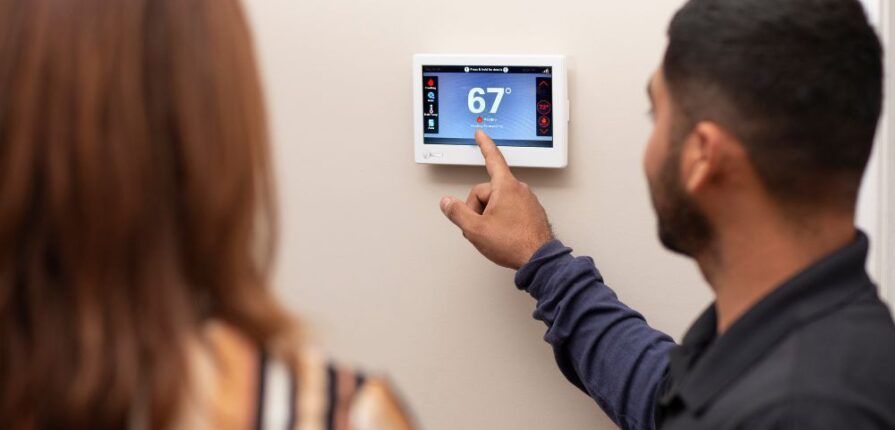Why Your Thermostat Might Be Overworking: Causes and Consequences
Your thermostat is a small but crucial component of your home’s HVAC system, responsible for maintaining the ideal indoor temperature by controlling heating and cooling cycles. However, when your thermostat overworks, it can lead to higher energy bills, discomfort, and even long-term damage to your HVAC system. Understanding why your thermostat might be overworking is the first step in preventing these issues and maintaining a comfortable, energy-efficient home. Let’s explore the common causes of an overworking thermostat, the consequences of this issue, and what you can do to mitigate it.
Common Causes of an Overworking Thermostat
- Poor Insulation
One of the primary reasons a thermostat might overwork is poor insulation. If your home is not well-insulated, heat can easily escape in the winter, and cool air can seep out in the summer. This causes the HVAC system to run more frequently to maintain the desired temperature, leading to an overworking thermostat. Common culprits include drafty windows, doors, or insufficient insulation in walls and attics. - Improper Thermostat Settings
Incorrect settings can also cause a thermostat to overwork. For example, setting the thermostat too high in the winter or too low in the summer forces the HVAC system to run continuously, trying to reach and maintain extreme temperatures. Similarly, setting the thermostat to “fan on” mode instead of “auto” can cause the fan to run constantly, increasing energy use and wear on the system. - Malfunctioning Thermostat
Sometimes, the thermostat itself may be the problem. A malfunctioning thermostat might incorrectly read the temperature, causing it to cycle the HVAC system on and off more frequently than necessary. This could be due to a faulty sensor, outdated technology, or simply a thermostat in need of recalibration. - Incorrect Thermostat Placement
The placement of your thermostat plays a significant role in its efficiency. If the thermostat is placed near a heat source, such as a window, lamp, or kitchen appliance, it can register a higher temperature than the rest of the house, causing the HVAC system to overwork. Similarly, placing a thermostat in a drafty hallway or an area with poor air circulation can lead to inaccurate readings. - HVAC System Issues
Problems within the HVAC system itself, such as a clogged air filter, dirty coils, or a malfunctioning component, can cause the system to work harder to maintain the desired temperature. This puts additional strain on the thermostat, leading to overworking.
Consequences of an Overworking Thermostat
- Increased Energy Bills
An overworking thermostat leads to increased energy consumption, which is directly reflected in your energy bills. The more frequently your HVAC system runs, the more electricity or gas it consumes, driving up costs. - Reduced Comfort
An overworking thermostat can result in temperature inconsistencies throughout your home, leading to discomfort. Rooms may feel too hot or too cold, making it difficult to maintain a comfortable environment. - Wear and Tear on HVAC System
Constant cycling and overuse can lead to premature wear and tear on your HVAC system. Components such as the compressor, fan motor, and belts may wear out faster, leading to costly repairs or replacements. Over time, this can shorten the overall lifespan of your HVAC system. - Potential System Failure
In extreme cases, an overworking thermostat can cause the HVAC system to fail entirely. Overuse and strain can lead to breakdowns, leaving you without heating or cooling when you need it most.
How to Mitigate an Overworking Thermostat
- Improve Insulation
Start by addressing insulation issues in your home. Seal drafts around windows and doors, add weather stripping, and consider upgrading insulation in your walls and attic. Proper insulation helps maintain consistent indoor temperatures, reducing the workload on your thermostat. - Adjust Thermostat Settings
Use energy-efficient thermostat settings to reduce strain on your HVAC system. Set the thermostat to a comfortable but moderate temperature, such as 68-70°F in the winter and 75-78°F in the summer. Utilize programmable thermostat settings to adjust temperatures automatically when you’re away from home or asleep. - Maintain Your HVAC System
Regular maintenance is key to preventing an overworking thermostat. Change air filters every 1-3 months, schedule annual HVAC inspections, and clean coils and vents as needed. Proper maintenance ensures your system runs efficiently and reduces the strain on your thermostat. - Upgrade to a Smart Thermostat
Consider upgrading to a smart thermostat, which offers advanced features such as self-diagnostics, remote control, and energy usage reports. Smart thermostats can learn your schedule and preferences, automatically adjusting settings to optimize comfort and energy efficiency. They also alert you to potential issues before they become major problems. - Reposition the Thermostat
If your thermostat is poorly placed, consider relocating it to a more central location away from direct sunlight, heat sources, or drafts. This ensures more accurate temperature readings and prevents the thermostat from overworking.
Conclusion: Proactive Steps for Efficiency and Comfort
An overworking thermostat can lead to increased energy bills, discomfort, and potential damage to your HVAC system. By understanding the causes and taking proactive steps to address them, you can ensure a more efficient, comfortable, and long-lasting heating and cooling system. At AirTexas, we’re here to help you maintain a healthy HVAC system. Contact us today for expert advice, maintenance services, or to learn more about smart thermostat options!

